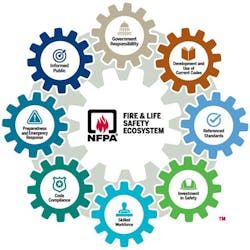After spending all my professional career in the electrical industry, 25 of which were in the electrical contracting side of the business, I have seen the good, the bad, and the ugly side of electrical installations. To be fair, I don’t believe that anyone ever intentionally sets out to perform a bad installation that is unsafe for the end-user, yet we see them regularly. Maybe there is a knowledge gap on how things should be done correctly or immense pressure to rush through a job based on workload demands. Whatever the reason, there seems to be a disconnect in many cases for performing a safe electrical installation.
Another thing that I have seen over the years in the electrical industry is an immense sense of pride in the trade. Electricians and electrical contractors are extremely prideful of the work they perform and the mark that it leaves in their communities. Without question, they want to leave a positive impact on the place that they call home.
When we start thinking about the role the electrical industry plays in the overall safety of the world, it is significant. The installations we provide can make a difference in the safety of a curious child if power is functioning for a critical, lifesaving surgery, or whether a home catches on fire or it doesn’t. What we do matters in the world. Working within the electrical industry, it is easy to have our blinders on and see only the immediate impact of our work, but there is so much more at stake.
Enter the NFPA Fire & Life Safety Ecosystem™. This ecosystem is a framework that identifies the components that must work together to minimize risk and help prevent loss, injuries, and death from fire, electrical, and other hazards. There are eight key components to the ecosystem:
- Government responsibility.
- Development and use of current codes.
- Referenced standards.
- Investment in safety.
- Skilled workforce.
- Code compliance.
- Preparedness and emergency response.
- Informed public.
It is important to understand that these components are interdependent. When they work together, the ecosystem protects everyone. If any component is missing or broken, the ecosystem can collapse, often resulting in tragedy. We can almost always trace the cause of injurious life safety incidents and tragedies back to the breakdown of one or more components. While the electrical industry does not have a direct impact on every component within the ecosystem, there are five that stand out; incorporating them into the work that we do will help to ensure safe electrical installations are being performed.
1. Development and use of current codes
This is a two-part component consisting of both the development and use of current codes. Let’s talk development to start. All NFPA codes and standards are created and updated each cycle through a full, open, consensus-based standards development process. It is important to know that there are roles for everyone in this process. All codes and standards have at least one — and many times multiple — committees of volunteers that oversee their development. For example, the National Electrical Code (NEC) has a significant number of Code-Making Panels (CMPs) that review the proposed changes each cycle. The 2026 NEC cycle that is being worked on right now has 18 CMPs. Electricians and electrical contractors are able and encouraged to apply to be on a CMP by visiting the NEC document information page and selecting the “Technical Committee” tab. You also have the opportunity to propose changes to the NEC by submitting a public input or public comment when the associated stage of the standards development process is open.
The other part of the current codes component is simply using them. Being on a three-year cycle allows the NEC to be updated to reflect the latest in safe installation requirements and technological advancements. Areas such as energy storage systems (ESSs), photovoltaic (PV) installations, and electric vehicles (EVs) all impact current electrical installations, making it crucial to utilize the most up-to-date code requirements to help ensure safety.
What may come as a surprise is that many states and jurisdictions fall short of enforcing the most current NEC by several editions. For example, some states still reference the 2008 NEC. It likely needs no explanation as to how much technology has advanced and safety needs have changed from 15-year-old Code cycles until now. While implementation of the most current codes and standards in communities often gets caught up in the legislative process, it is important to know that as electricians and electrical contractors (and as citizens) you have a voice in that process. Find time to explain to your local legislators why using the most current codes and standards is critical to the safety of your community.
2. Investment in safety
As an electrical contractor, it’s clear that our people are our most valuable asset. Without them, the work that we do can’t be done. The safety of employees needs to be paramount in a business. There is not only a legal responsibility from an OSHA standpoint but also an ethical responsibility to ensure that all employees go home at night the same way they came to work. The safety of employees simply can’t happen without an investment. Employees need to be trained regularly for safety in the specific tasks they perform. That goes for electrical-related tasks or other items such as operating a scissor lift or utilizing powder-actuated equipment. Employees should be trained to identify and manage any risks they face while performing their jobs. Treat them as the most important asset to the business because they are.
3. Skilled workforce
Technical training is also key to developing a skilled workforce. This is in the best interest of the community because safe installations can only be performed by those who are skilled in what they do. It is also crucial to the business’s bottom line. Workers skilled in what they do can perform the work expediently and accurately, both of which are huge benefits to the business from a competitive advantage and potential profit standpoint. Rework and reinspection fees can cost a business a significant amount of money. With thin profit margins, these costs can turn a project from a money-maker to a loss in the blink of an eye. There is no doubt that training employees has a large cost associated with it, but it can be argued that not training your employees has an even greater cost.
4. Code compliance
Code compliance goes hand-in-hand with using the most current codes. Utilizing the most current codes for installations is the best way to ensure it is safe, but there is also a need to verify that those requirements have indeed been met. That is where the authority having jurisdiction (AHJ) comes into play. The AHJ is the last line of defense between a safe electrical system for the end-user and an unsafe one. They need to be fully involved in the installation and closeout process. Pull the permit, get the proper job progress inspections (e.g., underground, rough wall, etc.), and then, the final inspection. Work that gets done without proper permits happens way too often and not only puts the electrical system owner and building occupants at risk, but it also puts the electrical contractor and electricians at risk of litigation, should something go wrong. Ensuring code compliance is a key part of safety for all involved.
5. Informed public
Post-installation considerations are just as important as the initial installation. Help others to understand the dangers of electricity. Often you may hear of individuals choosing to perform their own electrical work at their home or business. They may even reach out to you for advice on how to do something. They must know that it isn’t work they should be doing. Just like an electrician wouldn’t attempt to do open heart surgery, which could negatively impact the life of one person, those who are not trained to do electrical work should not attempt something that can impact the lives of many.
It is also important at the end of an installation to make sure that the homeowner or business owner is aware of how their electrical system and its components work, specifically noting what needs to be maintained. It may even be a good time to offer a service contract where you can offer continual service. The key point is don’t just perform the installation and walk away. Be sure to take the time to talk with customers and answer any questions they may have to ensure they fully understand their electrical system including maintenance needs, and other ways to stay safe.
Conclusion
Those who work in the electrical industry play a monumental role in safety all over the world. Being responsible for installing and maintaining electrical systems that others depend on for functionality and safety is a role that should not be taken lightly. Remember, if one component fails, they all fail. Whether it is lighting up a dark room or powering up a manufacturing machine, success in the electrical industry is achieved by making things work safely. Knowing how important our role of safety is in the cohesive world around us, I encourage everyone to begin implementing the five components of the Ecosystem discussed in this article in all your future installations.
Important Notice: Any opinion expressed in this column is the opinion of the author and does not necessarily represent the official position of NFPA or its Technical Committees. In addition, this piece is neither intended nor should it be relied upon to provide professional consultation or services.
About the Author
Corey Hannahs
Corey Hannahs is a senior electrical content specialist at the National Fire Protection Association (NFPA). In his current role, he serves as an electrical subject matter expert in the development of products and services that support NFPA documents and stakeholders. Corey is a third-generation electrician, holding licenses as a master electrician, contractor, inspector, and plan reviewer in the state of Michigan. Having held roles as an installer, owner, and executive previously, he has also provided electrical apprenticeship instruction for over 15 years. He serves on the technical committees for UL 2272, Electrical Systems for Personal E-Mobility Devices, and UL 2849, Electrical Systems for Ebikes. Corey was twice appointed to the State of Michigan’s Electrical Administrative Board by former Governor Rick Snyder, and he received United States Special Congressional Recognition for founding the B.O.P. (Building Opportunities for People) Program, which teaches construction skills to homeless and underprivileged individuals. He can be reached at [email protected].


